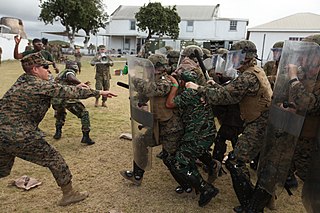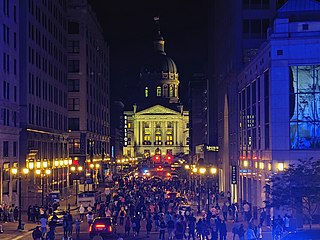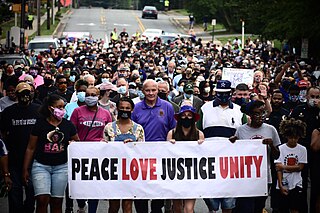
A black bloc is a tactic used by protesters who wear black clothing, ski masks, scarves, sunglasses, motorcycle helmets with padding or other face-concealing and face-protecting items. The clothing is used to conceal wearers' identities and hinder criminal prosecution by making it difficult to distinguish between participants. It is also used to protect their faces and eyes from pepper spray, which is used by police during protests or civil unrest. The tactic also allows the group to appear as one large unified mass. Black bloc participants are often associated with anarchism, anarcho-communism, communism, libertarian socialism and the anti-globalization movement. A variant of this type of protest is the Padded bloc, where following the Tute Bianche movement protestors wear padded clothing to protect against the police.

The 1999 Seattle WTO protests, sometimes referred to as the Battle of Seattle, were a series of anti-globalization protests surrounding the WTO Ministerial Conference of 1999, when members of the World Trade Organization (WTO) convened at the Washington State Convention and Trade Center in Seattle, Washington on November 30, 1999. The Conference was to be the launch of a new millennial round of trade negotiations.

Riot control measures are used by law enforcement, military, paramilitary or security forces to control, disperse, and arrest people who are involved in a riot, unlawful demonstration or unlawful protest.

The Seattle Mardi Gras riot occurred on February 27, 2001, when disturbances broke out in the Pioneer Square neighborhood during Mardi Gras celebrations in Seattle, Washington. There were numerous random attacks on revelers over a period of about three and a half hours. There were reports of widespread brawling, vandalism, and weapons being brandished. Damage to local businesses exceeded $100,000. About 70 people were reported injured. Several women were sexually assaulted. One man, Kris Kime, died of injuries sustained during an attempt to assist a woman being brutalized.
Jim Torrey is an American politician who served as mayor of Eugene from 1997 to 2004. Torrey was nominated in 2006 for an Oregon State Senate seat, but was defeated by incumbent Vicki Walker. He then served was elected to the Eugene School Board as Representative 5 in 2007, but was defeated by Shabram Martina in 2019. Torrey was first elected to public office at the age of 21, when he won a seat on the Waldport, Oregon, city council.

Battle in Seattle is a 2007 political action-thriller film written and directed by Stuart Townsend, in his directorial debut. The story is loosely based on the protest activity at the WTO Ministerial Conference of 1999. The film had its world premiere at the Toronto International Film Festival on September 8, 2007. It later screened at the Seattle International Film Festival in May 2008 and received a limited theatrical release on September 19, 2008.

The 1968 Democratic National Convention protests were a series of protests against the United States' involvement in the Vietnam War that took place prior to and during the 1968 Democratic National Convention in Chicago, Illinois. The protests lasted approximately seven days, from August 23 to August 29, 1968.

Kettling is a police tactic for controlling large crowds during demonstrations or protests. It involves the formation of large cordons of police officers who then move to contain a crowd within a limited area. Protesters either leave through an exit controlled by the police, leave through an uncontrolled gap in the cordons, or are contained, prevented from leaving, and arrested.

The UC Davis pepper spray incident occurred on November 18, 2011, during an Occupy movement demonstration at the University of California, Davis. After asking the protesters to leave several times, university police pepper sprayed a group of student demonstrators as they were seated on a paved path in the campus quad. The video of UC Davis police officer Lt. John Pike pepper-spraying demonstrators spread around the world as a viral video and the photograph became an Internet meme. Officer Alex Lee also pepper sprayed demonstrators at Pike's direction.
Starting in May 2020, protests following the murder of George Floyd were held in the city of Portland, Oregon, concurrent with protests in other cities in the United States and around the world. By July 2020, many of the protests, which had been held every day since May 28, drew more than 1,000 participants. Protests continued into August, September, and October 2020, often drawing hundreds.

The George Floyd protests and riots in Philadelphia were a series of protests and riots occurring in the City of Philadelphia. Unrest in the city began as a response to the murder of George Floyd in police custody in Minneapolis on May 25, 2020. Numerous protests, rallies and marches took place in Philadelphia in solidarity with protestors in Minneapolis and across the United States. These demonstrations call for justice for Floyd and protest police brutality. After several days of protests and riots, Philadelphia leadership joined other major cities, including Chicago in instituting a curfew, beginning Saturday, May 30, at 8 p.m. The protests concluded on June 23, 2020.

The city of Seattle experienced protests over the murder of George Floyd in 2020 and 2021. Beginning on May 29, 2020, demonstrators took to the streets throughout the city for marches and sit-ins, often of a peaceful nature but which also devolved into riots. Participants expressed opposition to systemic racism, police brutality and violence against people of color.
This is a list of George Floyd protests in Alabama, United States. Protests occurred in fourteen various communities in the state.

This is a list of George Floyd protests in Indiana, United States. As of July 2020, protests had occurred in at least 25 communities throughout the state.

This is a list of protests that took place in Michigan in 2020 following the murder of George Floyd.

This is a list of George Floyd protests in North Carolina, United States.
Local protests in the Minneapolis–Saint Paul metropolitan area quickly spread nationwide in more than 2,000 cities and towns, as well as over 60 countries internationally in support of the Black Lives Matter movement. In Minneapolis, destruction of property began on May 26, 2020, with the protests involving vandalism and arson. Demonstrations in many other cities also descended into riots and widespread looting. There was police brutality against protesters and journalists. Property damage estimates resulting from arson, vandalism and looting ranged from $1 to $2 billion, eclipsing the highest inflation adjusted totals for the 1992 Los Angeles riots.
Eugene has a long history of community activism, civil unrest, and protest activity. Eugene's cultural status as a place for alternative thought grew along with the University of Oregon in the turbulent 1960s, and its reputation as an outsider's locale grew with the numerous anarchist protests in the late 1990s. According to the Chicago Tribune, the city was called a "cradle to [the] latest generation of anarchist protesters." Occupy Eugene was home to one of the nation's longest-lasting Occupy protests in 2011, with the last protester leaving the initial Occupy camp on December 27, 2011. The city received national attention during the summer of 2020, after Black Lives Matter protests in response to the murder of George Floyd grew violent.













